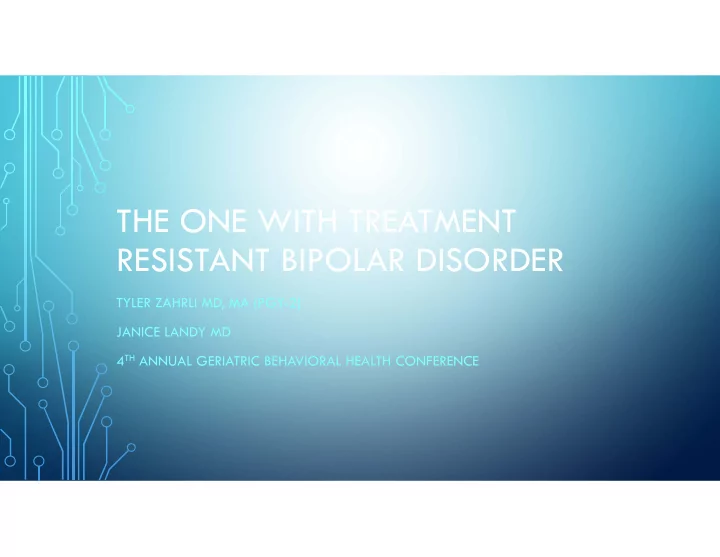

THE ONE WITH TREATMENT RESISTANT BIPOLAR DISORDER TYLER ZAHRLI MD, MA (PGY-2) JANICE LANDY MD 4 TH ANNUAL GERIATRIC BEHAVIORAL HEALTH CONFERENCE
NO DISCLOSURES
OBJECTIVES • Describe diagnostic criteria for Bipolar I Disorder • Identify three alternatives to lithium for Bipolar I Disorder in the geriatric patient population. • Identify side effects to commonly prescribed mood stabilizing medications. • Employ strategies for mood stabilization in the geriatric patient population.
CASE-HPI 82-year-old male with past medical history significant for HTN and Bipolar I Disorder and HTN who presents to hospital with lower extremity erythema as well as decreased need for sleep and changes in behavior.
CASE-HPI CONTINUED • Patient managed multiple decades on lithium • Hospital admission for lithium toxicity earlier in year • Lithium stopped • Patient not immediately restarted on mood stabilizing agent • History of prolonged admissions related to Bipolar I diagnosis
H&P • Patient had prescriptions for olanzapine and valproic acid, non-adherent • No substance misuse • Allergies: Tegretol • Lives with son, enjoys gardening • Active senior at baseline
MANIA STANDARD APPROACH • Grandiosity • Acute mania inpatient • Decreased need for sleep • Mood stabilizer • Atypical antipsychotic • Pressured/Increased speech • Flight of ideas • Distractibility • Increased goal-directed activity • Reckless behavior
LITHIUM • Approved for acute mania and bipolar maintenance therapy • Mechanism-of-action unknown but activity on sodium transporters and alters metabolism of specific neurotransmitters • Relative contraindication with renal and cardiac impairment
CASE-HPI CONTINUED • Patient admitted to medicine for cellulitis and eventually transferred to psychiatry unit • Standard approach to treatment initiated for acute mania
MEDICATION OPTIONS IN ACUTE MANIA • Mood stabilizers • Atypical antipsychotics • Typical antipsychotics • Benzodiazepines
MEDICATION TRIALS AND EFFECTS 1. Valproic acid and risperidone-Parkinsonian side effects, intolerable, minimal sleep, agitation 2. Valproic acid and quetiapine-Parkinsonian side effects and sedation, intolerable, varying sleep minimal, agitation 3. Valproic acid and chlorpromazine (low-dose)-Varying levels of sedation, mood more stable, minimal sleep, decreased agitation, mild parkinsonian side effects 4. Valproic acid, lithium (low-dose), chlorpromazine (low-dose)-increased creatinine, mood improved, varying sleep, no agitation, mild parkinsonian side effects 5. Valproic acid, chlorpromazine (low-dose), temazepam (low-dose)-mood depressed, decreased energy, no agitation, improved sleep, mild parkinsonian side effects 6. Chlorpromazine (low-dose), temazepam-mood lability, agitation, decreased sleep, less sedation, mild parkinsonian side effects 7. Oxcarbazepine, chlorpromazine (low-dose), temazepam-improved sleep, no agitation, improved mood, adequate energy, mild parkinsonian side effects. However, developed allergic reaction. 8. Lorazepam-adequate sleep, mood lability, agitation 9. Chlorpromazine-parkinsonian side effects, sedation, mood lability, varying sleep
VALPROIC ACID • Acute mania and maintenance • Blocks voltage-sensitive sodium channels and increases GABA • CNS side effects-sedation, confusion, appetite changes, weakness • Caution in elderly • Multiple formations available
OLANZAPINE • Atypical antipsychotic with mood stabilizing properties • Ideal initial step with mood stabilizer in acute mania • Sedation and weight gain • Can contribute to delirium
RISPERIDONE • Thought dopamine and 5HT2A activity contributes to mood stabilizing effects • Comparative increased D2 activity • Aggressive behavior and affective instability
QUETIAPINE • Mood effects due to serotonin activity • Weakly dopaminergic • Decreased concerns of parkinsonian side effects • Sedating, metabolic side effects
CHLORPROMAZINE • Low-potency antipsychotic • Mood stabilizing properties • CNS depression, cardiac risk, hypotension • Cautious use in geriatric patients
GOALS OF CARE • Stabilize • Minimize side effects • Minimize hospitalization time
APPROACH TO GERIATRIC PATIENTS • Begin treatment with standard approach • Consider starting at lower doses • If standard approach fails, theory-based approach for optimal medication • Consider using multiple medications at lower doses • Monitor closely for side effects • Physical therapy
REFERENCES American Psychiatric Association. (2013). Diagnostic and statistical manual of mental disorders (5 th ed.). Washington, DC. Dols, A., Beekman, A. Older Age Bipolar Disorder. Clinics in geriatric medicine 2020;36(2): 281-296. Sadock, B. J., Kaplan, H. I., & Sadock, V. A. (2007). Kaplan & Sadock's synopsis of psychiatry: Behavioral sciences/clinical psychiatry (10th ed.). Philadelphia: Wolter Kluwer/Lippincott Williams & Wilkins. Sajatovic, M, et al. A report on older-age bipolar disorder from the International Society for Bipolar Disorders Task Force. Bipolar Disorders 2015;17:689-704. Stahl, S. M. (2013). Stahl's essential psychopharmacology: Neuroscientific basis and practical applications (4th ed.). Cambridge University Press. Yatham, L., et al. Canadian Network for Mood and Anxiety Treatments (CANMAT) and International Society for Bipolar Disorders (ISBD) 2018 guidelines for the management of patients with bipolar disorder. Bipolar Disorders 2018;20(2):97-170.
QUESTIONS?
Recommend
More recommend